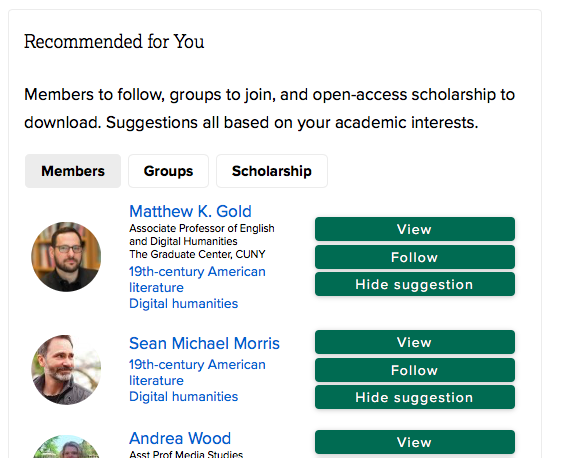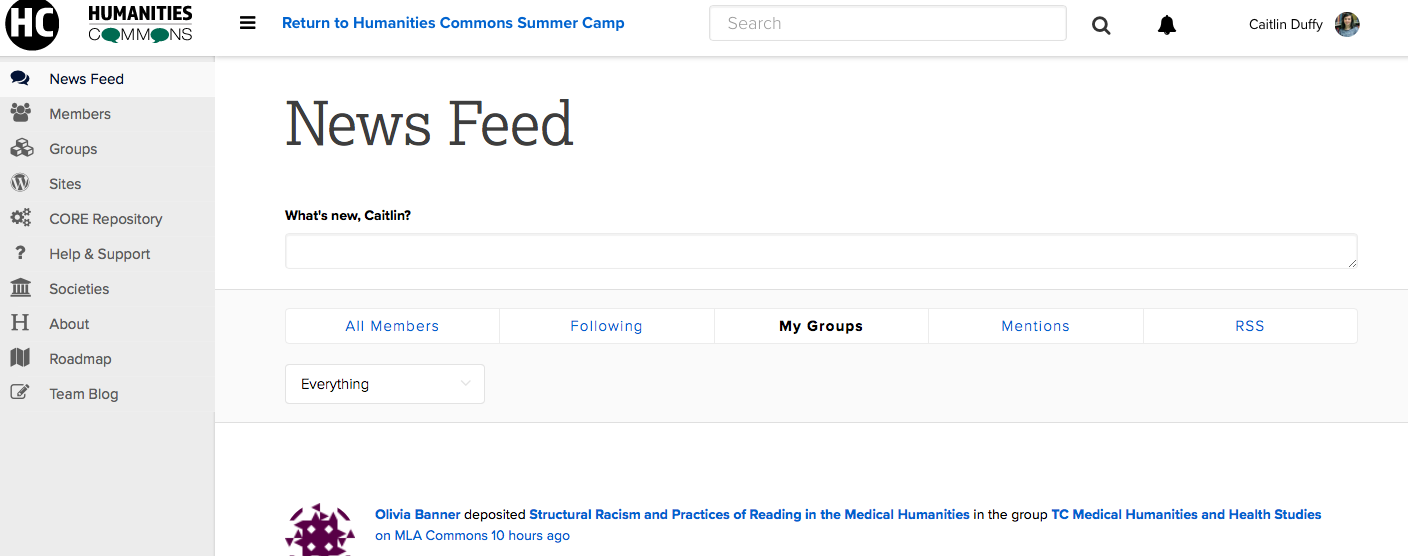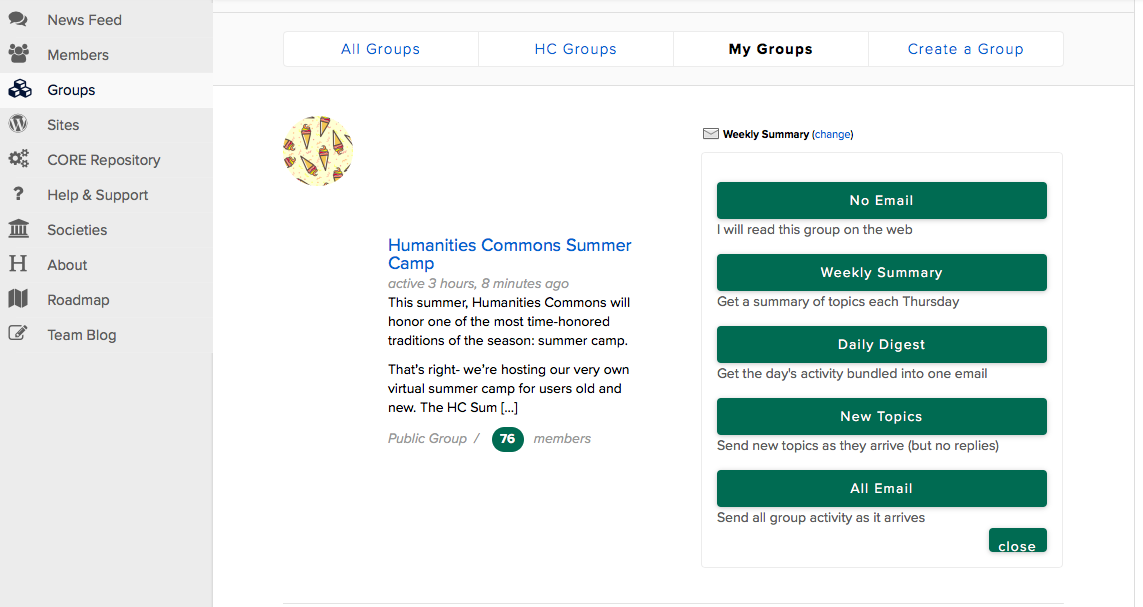Interested in completing an extra networking challenge?
Our second mini challenge involves creating a Humanities Commons group of your own.

Why Should I Create a New Humanities Commons Group?
There are a number of reasons you might start a new group on Humanities Commons, but perhaps the most important reason is that there is a need for this sort of group. While looking for a group to join in order to complete Challenge #2, did you discover that we are missing a group that you might like to join? For example, when I first joined Humanities Commons, I realized that nobody had built a group for all graduate students on the Commons, so I created one myself.
By creating a group, you provide other members interested in or connected to the group’s topic a space to connect and share work, opportunities, and ideas. While our groups share these similar benefits, there are three major different types of groups that you can create.
Using Groups for Different Purposes
On Humanities Commons, there are many different groups that serve many different purposes. While creating your own group, you’ll need to decide its type and purpose. Humanities Commons offers different levels of visibility for your group. Your selection of a visibility level for the group should be directly tied to your group’s purpose. Here are a few examples to get you started:
- Public Group: Public groups are completely visible to everyone and anyone can join simply by clicking the “Join Group” button on the group’s page. Choosing this visibility is advisable for groups that are focused on scholarly disciplines and/or academic interests. Example Groups: Medical Humanities, Digital Humanists, Education and Pedagogy, LGBTQ Studies, etc.
- Private Group: In private groups, users must request membership and be approved by a group admin or moderator in order to join the group. Private groups are still listed in the Humanities Commons group directory but their content and activity are visible only to accepted members. Choosing this visibility option is advisable if you’d like your activity to remain private while still allowing Humanities Commons users to see your group in the directory and request to join it. This setting might be especially good for working groups. Example Groups: 2016-17 Proseminar Fellows, Graduate Students, Connected Academics, etc.
- Hidden Group: Under this visibility setting, your group will not be listed in the groups directory or any searches. Only users who receive an invitation can join and see the group content and activity. Choosing this visibility option is advisable if you want to keep your group and its content entirely private. This might work best for groups from a specific department or school who are not looking for any outside members.
Creating a New Humanities Commons Group: The Basics
In order to create a new group, first go to the Groups page by click on “Groups” in the left-hand menu below the Humanities Commons logo. Once you’re on the page, click the green “Create a Group” button near the top of the page.
This will take you to the form for new groups. You will be asked to input information regarding your group, including its title, privacy setting, and description. A few areas of the form are not required, including the group’s cover image and photo, as well as the group’s site. While these aspects are not needed, you might consider adding them in order to build your group’s appearance and presence online. Images help to make your group appear more inviting, active, and professional.
A group site can help to raise more awareness of your group and it can provide a secondary space for your group to discuss key issues. A site might be especially helpful for a private or hidden group because it can be a space to share your group’s work with the public. That being said, make sure that you are able and willing to maintain a group site before you build it!
Gaining Group Members
A newly created group always feels a bit lonely. You’ll want to get people to join your group quickly because this will lead to a more active group, which will, in turn, cause even more people to join.
- Advertise on Social Media: Use your other social media accounts (ie: Twitter, Facebook, Reddit, etc.) to get the word out about your Humanities Commons group. Chances are you are already connected to other like-minded academics who may be interested in your group’s topic. Ask your members to also share the group on their social media accounts.
- As you share your group on social media, consider what sort of posts gain traction on that specific social platform. For example, will adding images or hashtags to the post help it to both be noticed and spread? Should you highlight something specific about your group rather than just the group’s title?
- Celebrate exciting discussions, new CORE deposits, events, etc. that occur within your group on social media. Your followers and friends will be encouraged to join your group by the wonderful work that is taking place.
- Entice potential members by gamifying the situation. Offer fun and creative incentives, such as “The tenth person to join our group will get a personal shout out on Twitter” or creating a quick digital graphic celebrating group milestones, such as the gaining of a twenty-fifth member.
- Advertise by Word of Mouth: Do you work with academics and educators who might be interested in joining this group? Tell them about it! Are you attending a conference which focuses on your group’s topic? Make a point to let fellow attendees know about your group while networking.
If your group is centered around a department at your university, school, or place of employment (ie: “Stony Brook University English Graduate Students”), you may also want to print out flyers advertising your group. Leave or post these in a common area, such as a break or copy room.

Encouraging Activity Within Your Group
Once you have group members, you need to make sure that your group is active. There are a number of different strategies you can take to help encourage participation within your group.
- Low-Stakes Questions: This works just as well in online groups as it does in classrooms. If you post a low-stake question, members will feel more comfortable answering it, as it’s something that they feel confident in answering. These questions should not be the sort that would take someone a while to come up with an answer. They serve mainly to open up dialogue and allow your members to test the waters before really engaging in deeper conversations. Below are some examples.
- Introductions: Briefly introduce yourself before asking other members to do the same. You can provide clear guidelines or even a list of information for these introductions to include, or you can let your members come up with what they might share. The introductions can include the member’s name, institution/workplace, designation, academic interests, current research, his or her reason(s) for joining the group, and/or a fun fact.
- Goals: Ask members not only why they joined the group, but what they want to gain from being a member. In an ideal world, what will this group accomplish and/or provide? Their answers will not only help to spark dialogue and activity, but they may also give you new ideas about what to do with your group.
- Recommended Reading/Viewing/Listening: Have you recently read a book or article that touches on topics important to your group’s focus? Or maybe you’ve watched a movie or listened to an album that does the same? Craft a recommendation post that not only encourages your members to check out your recent discovery, but welcomes them to share their own recent finds. Even if you don’t have anything in mind to recommend to the group, you can craft a simple discussion post that asks others to share the things they’ve recently discovered and loved.
- Victories: Start a discussion by asking members to share a recent professional or personal victories. You might want to make this a weekly or monthly tradition if it goes over well with your members. Sharing victories will not only inspire good feelings in your group members, but this activity can also potentially become a treasure trove a good ideas and best practices. For example, members may share a lesson plan or classroom activity that worked really well with their students.
- Group Traditions: Creating weekly, monthly, or even annual traditions on your group can give your members even more of a reason to keep up to date with your group. They can also help to create a group culture of community and support. These traditions can take place in a discussion topic thread that you start.
- Victories: Ask group members to share their victories of the week/month/year. These victories can be big or small, personal or professional. What matters is that they matter enough for your group members to want to share. Sharing victories will not only inspire good feelings in your group members and dialogue in your group, but this activity can also potentially become a treasure trove a good ideas and best practices. For example, members may share a lesson plan or classroom activity that worked really well with their students.
- Check-Ins: Have group members share something that they are celebrating or something that they have learned or discovered that week/month/year.
- Celebrations: Highlight and celebrate the work shared by your members on CORE and other areas of the Commons. When group members deposit their work in CORE and share it with your group, make a point to shout out their contribution on your group’s discussion page. A simple comment reminding other members to check out the new deposit and thanking that member for sharing it could help to encourage further participation. For example, members may begin shouting out each other or sharing their other work (ie: blogs, digital projects, etc).

- Group Events: The “Discussion” option in HC groups can allow people from across the globe to connect and ‘hang out.’ Take advantage of these affordances by scheduling times for digital group events. Remember to use the group’s calendar once your event is scheduled!
- Book Clubs: Select a book/article/movie/etc. pertinent to your group. It might be easier to start with something small like an article. Rather than choosing the text yourself, you may also want to create a poll and/or ask your members what they’d like to examine. You might also want to choose articles uploaded and written by group members. Once you’ve decided on a text, encourage your members to read the text by a certain date. On the scheduled date and time, you and your group members can meet in the discussion group to chat about the text. Book club meet-ups can become a monthly tradition for your group. After the meeting, you or another group member can post a summary of the discussion.
- Topic Meets: Choose a topic or question pertinent to your group. Schedule a time for group members to meet online to discuss the issue.
- Expert Meets: If you find out that a member of your group has a recent accomplishment (ie: a great lesson plan, a published book, completion of a digital project, etc.), ask them if they would be willing to discuss it with the group. Schedule a time and date for the group to meet digitally. Encourage the “expert” to have a short 10-15 minute presentation of their accomplishment and for group members to arrive to the digital meet-up with questions for the presenter.
Share Your Completed Challenge
Of course, most of the steps described in the blog post will not be completed in a week. This is something that you will continue to build and maintain beyond the scope of this summer camp.
That being said, we would love to see your new groups! Share your new group with the HC Summer Camp by using the discussion thread designated for this mini-challenge. If you’re on Twitter, please share your group using the #HCSummerCamper hashtag. This is a great way to get new members, so you might also want to include a brief description of your group’s focus. Check out (and join) other campers’ groups as you complete this advanced challenge.
If you have any questions or if you run into any issues as you complete our second mini challenge, fear not! Your camp director is here to help. Reach out to the Humanities Commons Summer Camp through any of the following contacts:
Humanities Commons: Post your question/concern as a new discussion thread in our HC Group.
Twitter: @humcommons
Email: CDuffy@mla.org or hello@hcommons.org






